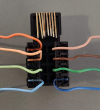thecomputerguy
Well-Known Member
- Reaction score
- 1,453
I've repaired a handful of patch cables before because I had to but I try to stay away from any wiring unless I have to.
Every cable repair I have done I have always done it to the ti-568B standard (apparently more common?) and they have always worked (dumb luck maybe?). I have a picture I printed of ti-568B and taped to my kit so I can use it for reference.
I have a cheapo kit I got from Amazon that came with a crimping tool, some passthrough Cat5e/Cat6 jacks and I have a super cheap cable tester/toner, all probably from china.
I did a fairly large job for a client and I need to replace a wall keystone jack (you know one of those things that clips into the wall plate then that terminates at the patch panel.
I don't know how the current broken keystone is wired (I forgot to look) and I don't know how it's wired at the patch panel and don't really have access to look.
I have keystone jacks I got from Home depot that show a template for ti-568A. Now I know I don't have to follow the picture and it can be punched down with my little plastic punch down tool in any order but can someone give me a quick crash course on this? Internet says as long as both ends are the same it doesn't matter.
Does that mean Keystone -> Patch panel = ti-568b
Then the patch cable from Patch panel -> switch
Must ALSO be ti-568?
Or can Keystone to Patch be 568A and patch cable 568B?
Do I just say screw it and follow the template on the keystone I got from home depot and if it doesn't work undo it and 568B it?
Every cable repair I have done I have always done it to the ti-568B standard (apparently more common?) and they have always worked (dumb luck maybe?). I have a picture I printed of ti-568B and taped to my kit so I can use it for reference.
I have a cheapo kit I got from Amazon that came with a crimping tool, some passthrough Cat5e/Cat6 jacks and I have a super cheap cable tester/toner, all probably from china.
I did a fairly large job for a client and I need to replace a wall keystone jack (you know one of those things that clips into the wall plate then that terminates at the patch panel.
I don't know how the current broken keystone is wired (I forgot to look) and I don't know how it's wired at the patch panel and don't really have access to look.
I have keystone jacks I got from Home depot that show a template for ti-568A. Now I know I don't have to follow the picture and it can be punched down with my little plastic punch down tool in any order but can someone give me a quick crash course on this? Internet says as long as both ends are the same it doesn't matter.
Does that mean Keystone -> Patch panel = ti-568b
Then the patch cable from Patch panel -> switch
Must ALSO be ti-568?
Or can Keystone to Patch be 568A and patch cable 568B?
Do I just say screw it and follow the template on the keystone I got from home depot and if it doesn't work undo it and 568B it?

